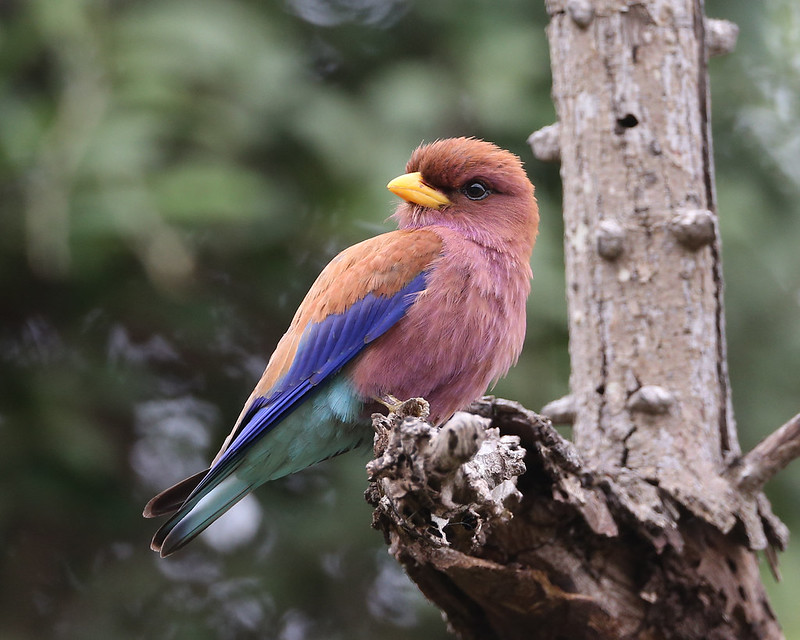
Broad-Billed Roller
Broad-Billed Roller
The Broad-Billed Roller: A Vivid Jewel of the Skies
Introduction
The Broad-billed Roller (Eurystomus glaucurus) is a strikingly beautiful bird that graces the skies of sub-Saharan Africa and parts of Madagascar. With its vibrant plumage, acrobatic flight displays, and unique ecological role, this species captures the fascination of birdwatchers, ornithologists, and nature lovers alike. In this comprehensive guide, we will explore the biology, behavior, habitat, and conservation status of this remarkable bird. We’ll also delve into its cultural significance and the best ways to observe it in the wild.
Taxonomy and Classification
The Broad-billed Roller belongs to the family Coraciidae, which includes other vividly colored rollers. It is classified as follows:
- Kingdom: Animalia
- Phylum: Chordata
- Class: Aves
- Order: Coraciiformes
- Family: Coraciidae
- Genus: Eurystomus
- Species: Eurystomus glaucurus
This species is closely related to the Dollarbird (Eurystomus orientalis), native to Asia and Australasia.
Physical Description
The Broad-billed Roller is a medium-sized bird, measuring approximately 29–32 cm in length. Its most distinctive features include:
- Broad, flattened bill: Adapted for catching insects mid-flight.
- Plumage: A dazzling mix of deep blue, turquoise, and chestnut brown.
- Wings: Long and pointed, with electric blue patches visible in flight.
- Tail: Slightly forked, aiding in aerial maneuverability.
- Eyes: Dark and expressive, set in a robust head.
The vibrant coloration serves both as camouflage in the canopy and as a visual signal during mating displays.
Distribution and Habitat
The Broad-billed Roller has a wide range across the African continent and parts of the Indian Ocean:
- Geographic Range:
- Sub-Saharan Africa
- Madagascar
- Comoros Islands
- Preferred Habitats:
- Open woodlands
- Savannahs
- Forest edges
- Mangroves
- Cultivated lands with scattered trees
This bird is a partial migrant, with northern populations moving south during the dry season.
Behavior and Diet
Feeding Habits
The Broad-billed Roller is an aerial insectivore, meaning it feeds primarily on flying insects. Its diet includes:
- Beetles
- Grasshoppers
- Termites
- Moths
- Dragonflies
It often hunts from a perch, launching into the air to snatch prey with precision. This behavior is known as “sallying.”
Social Behavior
- Typically seen alone or in pairs
- Occasionally forms small groups during migration
- Territorial during the breeding season
Vocalizations
Its call is a harsh, chattering “kraak-kraak,” often heard during flight or when defending territory.
Breeding and Reproduction
Mating Rituals
Courtship involves spectacular aerial displays, including dives, rolls, and wing clapping. Males showcase their agility and plumage to attract females.
Nesting
- Nest Sites: Tree cavities, often abandoned woodpecker holes
- Nest Materials: Minimal; the cavity itself provides protection
- Clutch Size: 2–4 eggs
- Incubation: Around 18–20 days
- Fledging: Chicks leave the nest approximately 25–30 days after hatching
Both parents share responsibilities in feeding and protecting the young.
Conservation Status
According to the IUCN Red List, the Broad-billed Roller is classified as Least Concern. However, certain threats persist:
Threats
- Habitat loss due to deforestation
- Pesticide use reducing insect populations
- Climate change affecting migratory patterns
Conservation Efforts
- Protected areas across Africa and Madagascar
- Community-based conservation initiatives
- Ecotourism promoting awareness and funding
Cultural Significance
In many African cultures, the Broad-billed Roller is seen as a symbol of freedom and agility. Its dazzling flight is often associated with the arrival of the rainy season, making it a harbinger of renewal.
In Malagasy folklore, the bird is believed to carry messages between the living and the ancestors, adding a spiritual dimension to its presence.
How to Spot the Broad-Billed Roller
Best Locations
- Kruger National Park, South Africa
- Okavango Delta, Botswana
- Masoala National Park, Madagascar
- Serengeti, Tanzania
Best Time to Observe
- Breeding Season: September to November
- Migration Periods: April to May and October to November
Tips for Birdwatchers
- Use binoculars with a wide field of view
- Look for perches near open clearings
- Listen for their distinctive calls
- Visit early in the morning or late afternoon
Conclusion
The Broad-billed Roller is more than just a pretty bird. It plays a vital role in maintaining ecological balance by controlling insect populations and serving as a bioindicator of environmental health. Its presence in diverse habitats across Africa and Madagascar is a testament to its adaptability and resilience.
Whether you’re a seasoned ornithologist or a curious traveler, witnessing the Broad-billed Roller in its natural habitat is a truly unforgettable experience. By supporting conservation efforts and promoting sustainable tourism, we can ensure that future generations will continue to marvel at this aerial acrobat.
Frequently Asked Questions (FAQ)
1. Where can I find the Broad-billed Roller?
You can spot the Broad-billed Roller across sub-Saharan Africa, Madagascar, and nearby islands. Look for them in open woodlands, savannahs, and forest edges.
2. What does the Broad-billed Roller eat?
Its diet consists mainly of flying insects such as beetles, grasshoppers, and dragonflies, which it catches mid-air using its broad bill.
3. Is the Broad-billed Roller endangered?
No, it is currently listed as Least Concern by the IUCN. However, habitat destruction and pesticide use are potential threats.
4. How does the Broad-billed Roller reproduce?
It nests in tree cavities, laying 2–4 eggs. Both parents incubate the eggs and feed the chicks until they fledge after about 25–30 days.
5. Why is it called the “Broad-billed” Roller?
The name comes from its distinctive, wide bill, which is adapted for catching large flying insects during flight
Summary
The Broad-billed Roller is a visually stunning bird native to Africa and Madagascar, known for its vibrant plumage, acrobatic flight, and insectivorous diet. It thrives in open woodlands and forest edges and plays a crucial role in ecosystem balance. While not currently endangered, ongoing conservation is essential to protect its habitat and food sources. Birdwatchers can spot this species in national parks across the continent, especially during the breeding and migration seasons.
